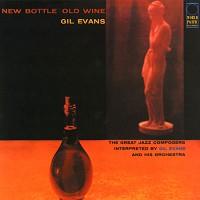Legendary Early World-Pacific Gil Album Now Available!
The arranger Gil Evans was on a roll when this cool, yet raucous big band set of standards was recorded in New York City back in 1958. The California native and big band veteran had already arranged Miles Davis’ Miles Ahead and the cool and deep Porgy and Bess. Featured soloist Cannonball Adderley’s Blue Note classic Somethin’ Else had also hit big by then (okay, it was really a Miles Davis album, but Cannonball’s playing heated up Miles’s cool show).
Despite its going almost “mainstream” at the time, jazz was torn apart and at a crossroad. Hard bop was cooling off, big bands were few and winding down, though Ellington and Basie forged on, and academics had begun the process of writing the history of the music with its future vitality uncertain.
How this set (and the follow up Great Jazz Standards recorded almost a year later) came to be would make for an interesting story, the pieces of which can be picked up from the credits. The jacket lists it as “A George Avakian production” (Avakian was the label’s A&R man and would go on to producing at Columbia Records). Though the album was recorded in New York City, it was originally issued on Richard Bock’s California-based World Pacific label, better known for its west coast jazz sound (the label also first issued Carl Reiner and Mel Brooks’ classic The 2000 Year Old Man album, later picked up by Capitol).
New Bottle Old Wine neatly sums up the concept: take the ripe old jazz classics “St Louis Blues,” “King Porter’s Stomp,” “Willow Tree,” and “Struttin’ With Some Barbecue,” and not so ripe bop era ones “Lester Leaps In,” “’Round About Midnight,” “Manteca!,” and “Bird Feathers,” and reinvent them and big band music in the process. The tunes are presented chronologically.
Evan’s brash arrangements might surprise those who only know him through his cool work for Miles Davis, yet even here cool brass elements sometimes prevail. Using top New York session men and some more prominent notables, Evans builds his case around a sumptuous brass cluster that supports generous, sometimes near neck-breaking solo outings by Addlerley, trombonist Frank Rehak, trumpeter Johnny Coles, and tuba player Bill Barber (erroneously listed as “John” in the notes) as well as guitarist Chuck Wayne. Evans toots his horn too.
With Art Blakey on drums (Philly Joe Jones playes on one tune) and Paul Chambers on bass, you can bet there’s plenty of drive behind these high-energy, groundbreaking (though overlooked) sessions that were issued on a two CD Blue Note set along with Great Jazz Standards. Blame the misspelling of Adderley’s name here (as “Adderly”) for its being misspelled on KOB and elsewhere.
The sonics here feature a great divide between the left and right channels, typical of the era. It’s not fatal though, because the instruments don’t sound placed in boxes on either side of the stage. Instead they appear to be well-recorded in an approximation of real stereo. However, the setting is overly cavernous, with too much reverb applied, probably in post production. Still, the effect is attractive, though it obscures and blunts some of the attractive hard edges that would be better served presented more directly.
Listen, Kind of Blue is a great album, and it continues to sell in big numbers, and deservedly so, ditto Somethin’ Else. If you like those, I guarantee you’ll love this as much if not more. Evans was a master painter whose brushstrokes in brass never lose their power.
- Log in or register to post comments




